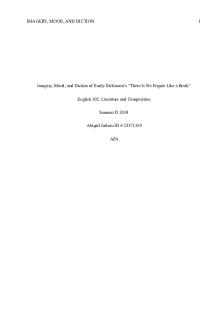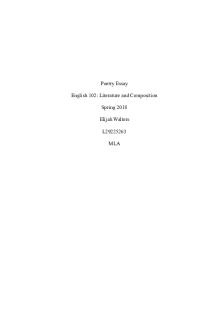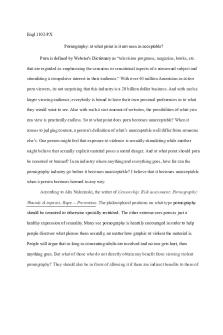Poetry Essay - Grade: 80% PDF

| Title | Poetry Essay - Grade: 80% |
|---|---|
| Course | Composition and Literature |
| Institution | Liberty University |
| Pages | 6 |
| File Size | 68.4 KB |
| File Type | |
| Total Downloads | 75 |
| Total Views | 144 |
Summary
Poetry Essay for ENGL 102. Analysis essay of Emily Dickinson's "There Is No Frigate Like a Book."...
Description
IMAGERY, MOOD, AND DICTION
1
Imagery, Mood, and Diction of Emily Dickinson’s “There Is No Frigate Like a Book” English 102: Literature and Composition Summer D 2019 Abigail Judson ID # 28571558 APA
IMAGERY, MOOD, AND DICTION
2
Thesis Statement and Outline Thesis Statement: Emily Dickinson’s “There is No Frigate Like a Book” is a fantastical poem bringing readers on an imaginary journey using imagery, light and freeing moods, as well as purposeful diction to demonstrate that there is no escape or adventure like the ones found while reading. I.
II.
Imagery and Mood a. Similes i. The line “no frigate like a book” (“No Frigate Like A Book,” line 1) compares a ship to a book in terms of traveling long distances or lengths of time. ii. The line “nor any coursers like a page” (Line 3) compares quick horses with a page of poetry in terms of traveling short distances or lengths. b. Personification i. The line “prancing poetry” (Line 4) allows readers to imagine riding away with a poem. ii. The similes “frigate like a book” (Line 1) and “coursers like a page” (Line 3) allow readers to imagine books sailing and pages running. c. Structure i. Ballad Stanza 1. Two quatrains with alternating iambic tetrameter and trimeter 2. First and third lines of each stanza do not rhyme “book…page” (“No Frigate Like a Book,” Lines 1 and 3) and “take…chariot” (Lines 5 and 7) 3. Using a ballad stanza creates a song-like quality in the poem and keeps the light adventurous tone of the poem. ii. Rhyme Scheme 1. “away…poetry” (Lines 2 and 4); slant rhyme 2. “toll…soul” (Lines 6 and 8) 3. The rhyme scheme of the poem is part of the ballad stanza, it maintains the song-like quality of the poem and allows the poem to flow easily. Diction a. Connotation and Denotation i. The use of the words “frigate” (line 1), “coursers” (line 3), “traverse” (line 5), and “chariot” (line 7) insinuate travel, adventure, and fantasy for the reader. ii. The words “human soul” (line 8) demonstrate the depth of feeling and attachment that can be found in writing.
IMAGERY, MOOD, AND DICTION
3
Imagery, Mood, and Diction of Emily Dickinson’s “There Is No Frigate Like a Book” Everyone has a desire to travel, to see the world, and to have some great adventure in their life, but it is not always possible to afford or find the time to do so. However, the strategic use of words and an open imagination can make any adventure possible. Emily Dickinson’s “There is No Frigate Like a Book” is a fantastical poem bringing readers on an imaginary journey using imagery, light and freeing moods, as well as purposeful diction to demonstrate that there is no escape from reality or wild adventure like the ones that can be found while reading. Dickinson’s use of imagery in the first stanza of her poem supports the theme that reading can bring about an adventure like no other and helps to build the light, adventurous mood of the poem. She uses similes and personification to create vivid images of a magical imaginary land into the reader’s mind. The line “no frigate like a book” (“No Frigate Like A Book,” line 1) compares a ship to a book in terms of traveling and sailing off on the next great adventure. This line also personifies books, giving them the power to sail and carry readers away, to escape their own reality. Another line, “nor any coursers like a page” (Line 3) compares swift horses with a page of poetry, giving poems the ability to ride off with a reader and bring them on a quick journey. These lines help to create the fantastical setting and sense of adventure that this poem is forming. The image is made even more detailed with the personification of poetry in the line “prancing poetry” (Line 4). The structure of the poem also assists in creating the light mood of the poem. Dickinson uses a ballad stanza for this poem, which consists of two quatrains with alternating iambic tetrameter and trimeter. This type of structure creates a song-like flow that allows the poem to be easily read and maintains a lighthearted feel. Also part of ballad stanza, the first and third lines of each stanza do not rhyme, “book…page” (“No Frigate Like a Book,” Lines 1 and 3) and “take…
IMAGERY, MOOD, AND DICTION
4
chariot” (Lines 5 and 7), while the second and fourth lines do rhyme, “away…poetry” (Lines 2 and 4) and “toll…soul” (Lines 6 and 8). The rhyme scheme, while part of ballad stanza, also emphasizes the parts of the poem that have the most meaning to the theme. The first rhyme “away…poetry” (Lines 2 and 4) draws the reader’s attention back to the idea that poetry can take you away, while the second rhyme “toll…soul” (Lines 6 and 8) brings about the idea that a literal adventure can take a toll, whether financially, physically, or mentally, but a literary adventure is good for the soul. The theme of adventure and escape is also supported through Dickinson’s use of purposeful diction. Dickinson’s words of choice have a specific connotation and denotation. The use of the words “frigate” (line 1), “coursers” (line 3), “traverse” (line 5), and “chariot” (line 7) insinuate travel, adventure, and fantasy for the reader. While each of these words contribute to the imagery and mood of the poem, due to their almost fairy tale and adventurous connotation, their denotation brings travel to mind as well. The reader is consistently being reminded of travel and escape through the use of these words in every other line, where the alternate lines remind the reader of books and poems. The words “human soul” (line 8) at the end of the poem are used to demonstrate the depth of feeling and attachment that can be found in literature and poetry. Dickinson relates the books and poems being read to vehicles being used to carry a person’s soul through the story being told. Dickinson’s final line brings the idea of adventure and escape to the forefront of the reader’s mind again due to the emotional connotation carried in the line. Throughout this poem, Dickinson uses literary devices such as imagery, mood, and diction to support the theme of finding adventure and escape in books and other writing. The fantastical imagery of sailing books and running pages created through similes and personification, along with the structure of the poem, bring about a light and adventurous mood
IMAGERY, MOOD, AND DICTION that makes the reader feel they have found one of the fantasylands of their wildest imaginations. Dickinson’s use of specific diction also facilitates the theme of the poem through connotation and denotation. After reading this poem, who would not want to find their own literary adventure?
5
IMAGERY, MOOD, AND DICTION
6 References
Dickinson, E. (n.d.). There is no frigate like a book. Retrieved from https://www.poetryfoundation.org/poems/52199/there-is-no-frigate-like-a-book-1286 (Original Source published in 1999)....
Similar Free PDFs

Poetry Essay - Grade: 80%
- 6 Pages

Poetry Essay - Grade: A+
- 5 Pages

Essay 3 - Grade: 80
- 4 Pages

Essay Poetry - Grade: A
- 3 Pages

Poetry Essay - Grade: B
- 5 Pages

ECH 80 Essay 1 - Grade: A-
- 2 Pages

Apple - Grade: 80
- 8 Pages

A1 - Grade: 80
- 5 Pages

Gout(notes) - Grade: 80
- 3 Pages

HD sample - Grade: 80%
- 16 Pages

Business summative - Grade: 80
- 17 Pages

FADO Music - Grade: 80%
- 7 Pages

Poetry Analysis Essay Examples
- 7 Pages
Popular Institutions
- Tinajero National High School - Annex
- Politeknik Caltex Riau
- Yokohama City University
- SGT University
- University of Al-Qadisiyah
- Divine Word College of Vigan
- Techniek College Rotterdam
- Universidade de Santiago
- Universiti Teknologi MARA Cawangan Johor Kampus Pasir Gudang
- Poltekkes Kemenkes Yogyakarta
- Baguio City National High School
- Colegio san marcos
- preparatoria uno
- Centro de Bachillerato Tecnológico Industrial y de Servicios No. 107
- Dalian Maritime University
- Quang Trung Secondary School
- Colegio Tecnológico en Informática
- Corporación Regional de Educación Superior
- Grupo CEDVA
- Dar Al Uloom University
- Centro de Estudios Preuniversitarios de la Universidad Nacional de Ingeniería
- 上智大学
- Aakash International School, Nuna Majara
- San Felipe Neri Catholic School
- Kang Chiao International School - New Taipei City
- Misamis Occidental National High School
- Institución Educativa Escuela Normal Juan Ladrilleros
- Kolehiyo ng Pantukan
- Batanes State College
- Instituto Continental
- Sekolah Menengah Kejuruan Kesehatan Kaltara (Tarakan)
- Colegio de La Inmaculada Concepcion - Cebu


